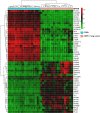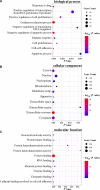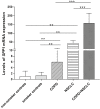High expression of SPP1 in patients with chronic obstructive pulmonary disease (COPD) is correlated with increased risk of lung cancer
- PMID: 33626243
- PMCID: PMC8016137
- DOI: 10.1002/2211-5463.13127
High expression of SPP1 in patients with chronic obstructive pulmonary disease (COPD) is correlated with increased risk of lung cancer
Abstract
Chronic obstructive pulmonary disease (COPD) is characterized by persistent airway inflammation and fixed airflow obstruction. Patients with COPD have increased risk of lung cancer (LC), and the coexistence of both diseases is associated with poorer survival. However, the mechanisms predisposing patients with COPD to LC development and poor prognosis remain unclear. Gene expression profiles were downloaded from the Gene Expression Omnibus. Twenty-two data sets were included (n = 876). We identified 133 DEGs and 145 DEGs in patients with COPD and LC compared with healthy controls, respectively. There were 1544 DEGs in patients with LC and coexisting COPD compared with COPD, and these DEGs are mainly involved in the cell cycle, DNA replication, p53 signalling and insulin signalling. The biological processes primarily associated with these DEGs are oxidation reduction and apoptosis. SPP1 was the only overlapping DEG that was up-regulated in patients with COPD and/or LC, and this was validated by qPCR in an independent cohort. The area under the curve value for SPP1 was 0.893 (0.822-0.963) for the prediction of LC in patients with COPD. High expression of SPP1 in patients with LC was associated with shorter survival time. Up-regulation of SPP1 may be associated with increased risk of LC in patients with COPD and therefore may have potential as a therapeutic target for LC in patients with COPD.
Keywords: SPP1; bioinformatics; chronic obstructive pulmonary disease; lung cancer; meta-analysis.
© 2021 The Authors. FEBS Open Bio published by John Wiley & Sons Ltd on behalf of Federation of European Biochemical Societies.
Conflict of interest statement
The authors declare no conflict of interest.
Figures







Similar articles
-
Identification and validation of SPP1 as a potential biomarker for COPD through comprehensive bioinformatics analysis.Respir Med. 2025 Feb;237:107953. doi: 10.1016/j.rmed.2025.107953. Epub 2025 Jan 18. Respir Med. 2025. PMID: 39832670
-
Higher Expression of SPP1 Predicts Poorer Survival Outcomes in Head and Neck Cancer.J Immunol Res. 2021 Dec 23;2021:8569575. doi: 10.1155/2021/8569575. eCollection 2021. J Immunol Res. 2021. PMID: 34977258 Free PMC article.
-
Profile of epigenetic mechanisms in lung tumors of patients with underlying chronic respiratory conditions.Clin Epigenetics. 2018 Jan 16;10:7. doi: 10.1186/s13148-017-0437-0. eCollection 2018. Clin Epigenetics. 2018. PMID: 29371906 Free PMC article.
-
Chronic obstructive pulmonary disease and lung cancer: new molecular insights.Respiration. 2011;81(4):265-84. doi: 10.1159/000324601. Epub 2011 Mar 24. Respiration. 2011. PMID: 21430413 Review.
-
The prognosis of non-small cell lung cancer combined with chronic obstructive pulmonary disease: A systematic review and meta-analysis.Clin Respir J. 2020 Apr;14(4):389-396. doi: 10.1111/crj.13144. Epub 2020 Feb 3. Clin Respir J. 2020. PMID: 31905419 Free PMC article.
Cited by
-
Isoforskolin modulates AQP4-SPP1-PIK3C3 related pathway for chronic obstructive pulmonary disease via cAMP signaling.Chin Med. 2023 Oct 10;18(1):128. doi: 10.1186/s13020-023-00778-w. Chin Med. 2023. PMID: 37817209 Free PMC article.
-
Salmonella enhances osteogenic differentiation in adipose-derived mesenchymal stem cells.Front Cell Dev Biol. 2023 Mar 15;11:1077350. doi: 10.3389/fcell.2023.1077350. eCollection 2023. Front Cell Dev Biol. 2023. PMID: 37009487 Free PMC article.
-
Gut Microbiome and Transcriptomic Changes in Cigarette Smoke-Exposed Mice Compared to COPD and CD Patient Datasets.Int J Mol Sci. 2024 Apr 5;25(7):4058. doi: 10.3390/ijms25074058. Int J Mol Sci. 2024. PMID: 38612871 Free PMC article.
-
Integrative weighted molecular network construction from transcriptomics and genome wide association data to identify shared genetic biomarkers for COPD and lung cancer.PLoS One. 2022 Oct 4;17(10):e0274629. doi: 10.1371/journal.pone.0274629. eCollection 2022. PLoS One. 2022. PMID: 36194576 Free PMC article.
-
Study on the Mechanism of Competing Endogenous Network of 'Scutellaria barbata D.Don-Houttuynia cordata- Radix Scutellariae' in the Treatment of NSCLC based on Bioinformatics, Molecular Dynamics and Experimental Verification.Curr Comput Aided Drug Des. 2025;21(3):403-423. doi: 10.2174/0115734099288771240419110716. Curr Comput Aided Drug Des. 2025. PMID: 38685811
References
-
- Vogelmeier CF, Criner GJ, Martinez FJ, Anzueto A, Barnes PJ, Bourbeau J, Celli BR, Chen R, Decramer M, Fabbri LM et al. (2017) Global strategy for the diagnosis, management, and prevention of chronic obstructive lung disease 2017 report: GOLD executive summary. Eur Respir J 49, 1700214. - PubMed
-
- Wang C, Xu J, Yang L, Xu Y, Zhang X, Bai C, Kang J, Ran P, Shen H, Wen F et al. (2018) Prevalence and risk factors of chronic obstructive pulmonary disease in China (the China Pulmonary Health [CPH] study): a national cross‐sectional study. Lancet 391, 1706–1717. - PubMed
-
- Lozano R, Naghavi M, Foreman K, Lim S, Shibuya K, Aboyans V, Abraham J, Adair T, Aggarwal R, Ahn SY et al. (2012) Global and regional mortality from 235 causes of death for 20 age groups in 1990 and 2010: a systematic analysis for the Global Burden of Disease Study 2010. Lancet 380, 2095–2128. - PMC - PubMed
Publication types
MeSH terms
Substances
LinkOut - more resources
Full Text Sources
Other Literature Sources
Medical
Research Materials
Miscellaneous

